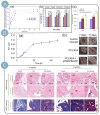Alginate-Based Electrospun Nanofibers and the Enabled Drug Controlled Release Profiles: A Review
- PMID: 39062503
- PMCID: PMC11274620
- DOI: 10.3390/biom14070789
Alginate-Based Electrospun Nanofibers and the Enabled Drug Controlled Release Profiles: A Review
Abstract
Alginate is a natural polymer with good biocompatible properties and is a potential polymeric material for the sustainable development and replacement of petroleum derivatives. However, the non-spinnability of pure alginate solutions has hindered the expansion of alginate applications. With the continuous development of electrospinning technology, synthetic polymers, such as PEO and PVA, are used as co-spinning agents to increase the spinnability of alginate. Moreover, the coaxial, parallel Janus, tertiary and other diverse and novel electrospun fiber structures prepared by multi-fluid electrospinning have found a new breakthrough for the problem of poor spinning of natural polymers. Meanwhile, the diverse electrospun fiber structures effectively achieve multiple release modes of drugs. The powerful combination of alginate and electrostatic spinning is widely used in many biomedical fields, such as tissue engineering, regenerative engineering, bioscaffolds, and drug delivery, and the research fever continues to climb. This is particularly true for the controlled delivery aspect of drugs. This review provides a brief overview of alginate, introduces new advances in electrostatic spinning, and highlights the research progress of alginate-based electrospun nanofibers in achieving various controlled release modes, such as pulsed release, sustained release, biphasic release, responsive release, and targeted release.
Keywords: alginate; biomedical; controlled release; drug delivery; electrospinning; nanostructure.
Conflict of interest statement
The authors declare no conflicts of interest.
Figures












Similar articles
-
Nanofibers: An Effective Tool for Controlled and Sustained Drug Delivery.Curr Drug Deliv. 2018 Feb 14;15(2):155-166. doi: 10.2174/1567201814666171002115230. Curr Drug Deliv. 2018. PMID: 28969554 Review.
-
Electrospun polymer micro/nanofibers as pharmaceutical repositories for healthcare.J Control Release. 2019 May 28;302:19-41. doi: 10.1016/j.jconrel.2019.03.020. Epub 2019 Mar 26. J Control Release. 2019. PMID: 30922946 Review.
-
Reverse Gradient Distributions of Drug and Polymer Molecules within Electrospun Core-Shell Nanofibers for Sustained Release.Int J Mol Sci. 2024 Sep 1;25(17):9524. doi: 10.3390/ijms25179524. Int J Mol Sci. 2024. PMID: 39273471 Free PMC article.
-
Biomedical application and controlled drug release of electrospun fibrous materials.Mater Sci Eng C Mater Biol Appl. 2018 Sep 1;90:750-763. doi: 10.1016/j.msec.2018.05.007. Epub 2018 May 4. Mater Sci Eng C Mater Biol Appl. 2018. PMID: 29853146 Review.
-
Drug-Loaded Halloysite Nanotube-Reinforced Electrospun Alginate-Based Nanofibrous Scaffolds with Sustained Antimicrobial Protection.ACS Appl Mater Interfaces. 2018 Oct 10;10(40):33913-33922. doi: 10.1021/acsami.8b11013. Epub 2018 Oct 1. ACS Appl Mater Interfaces. 2018. PMID: 30220194
Cited by
-
Shell Distribution of Vitamin K3 within Reinforced Electrospun Nanofibers for Improved Photo-Antibacterial Performance.Int J Mol Sci. 2024 Sep 3;25(17):9556. doi: 10.3390/ijms25179556. Int J Mol Sci. 2024. PMID: 39273503 Free PMC article.
-
Synergistic Effects of Radical Distributions of Soluble and Insoluble Polymers within Electrospun Nanofibers for an Extending Release of Ferulic Acid.Polymers (Basel). 2024 Sep 15;16(18):2614. doi: 10.3390/polym16182614. Polymers (Basel). 2024. PMID: 39339078 Free PMC article.
-
Leveraging flexible pipette-based tool changes to transform liquid handling systems into dual-function sample preparation and imaging platforms.HardwareX. 2025 May 2;22:e00653. doi: 10.1016/j.ohx.2025.e00653. eCollection 2025 Jun. HardwareX. 2025. PMID: 40546787 Free PMC article.
-
Multi-functional dressings for recovery and screenable treatment of wounds: A review.Heliyon. 2024 Dec 24;11(1):e41465. doi: 10.1016/j.heliyon.2024.e41465. eCollection 2025 Jan 15. Heliyon. 2024. PMID: 39831167 Free PMC article. Review.
-
Janus LAAM-loaded electrospun fibrous buccal films for treating opioid use disorder.Biomaterials. 2025 Jun;317:123041. doi: 10.1016/j.biomaterials.2024.123041. Epub 2024 Dec 22. Biomaterials. 2025. PMID: 39753084
References
-
- Rezaei S., Valipouri A., Hosseini Ravandi S.A., Kouhi M., Ghasemi Mobarakeh L. Fabrication, Characterization, and Drug Release Study of Vitamin C–Loaded Alginate/Polyethylene Oxide Nanofibers for the Treatment of a Skin Disorder. Polym. Adv. Technol. 2019;30:2447–2457. doi: 10.1002/pat.4692. - DOI
Publication types
MeSH terms
Substances
LinkOut - more resources
Full Text Sources
Miscellaneous

